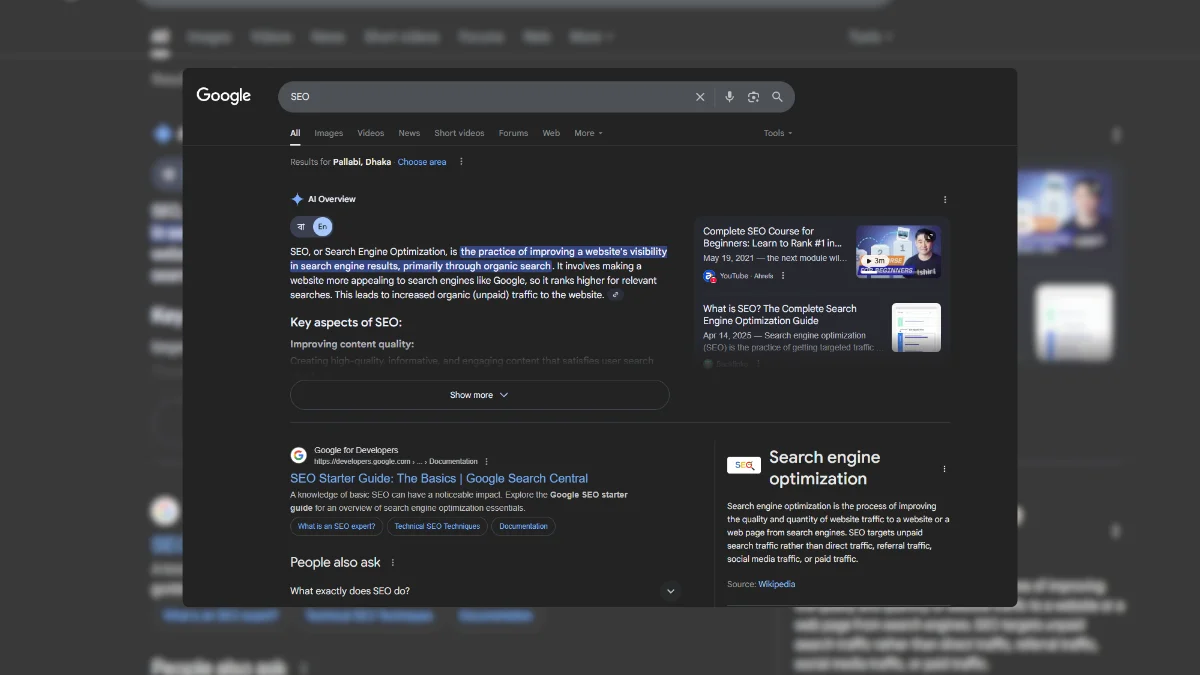
What Are SERPs?
Search Engine Results Pages, commonly known as SERPs, are the heart of the online search experience. When you type a query into a search engine like Google, Bing, or Yahoo, the results displayed are collectively referred to as the SERP. These pages are more than just a list of links—they’re a dynamic, carefully curated snapshot of the web, shaped by complex algorithms to deliver the most relevant and useful information to users. In this in-depth guide, we’ll explore what SERPs are, how they work, their key components, and why they matter for businesses, marketers, and everyday users in 2025. Whether you’re new to digital marketing or an experienced SEO professional, this guide will provide a thorough understanding of SERPs and their role in the digital landscape.
Introduction to SERPs
A Search Engine Results Page (SERP) is the page displayed by a search engine in response to a user’s query. It’s the interface where users find answers, discover websites, and interact with various types of content, from blog posts to videos to advertisements. SERPs are the gateway to the internet, influencing how users navigate the vast digital world.
In 2025, SERPs are more sophisticated than ever, incorporating rich media, AI-driven features, and personalized results to enhance user experience. For businesses and website owners, understanding SERPs is critical because ranking high on these pages drives organic traffic, boosts brand visibility, and increases conversions. This guide dives deep into the anatomy of SERPs, their evolution, and strategies to optimize for them.
How SERPs Work
Search engines like Google use complex algorithms to generate SERPs. These algorithms analyze billions of web pages, rank them based on relevance and authority, and present the most suitable results to users. The process involves three key stages:
-
Crawling: Search engines deploy bots (e.g., Googlebot) to explore the web, discovering new and updated pages.
-
Indexing: The crawled pages are stored in a massive database, organized for quick retrieval.
-
Ranking: When a user enters a query, the search engine evaluates indexed pages against hundreds of ranking factors (e.g., relevance, content quality, backlinks) to determine their order on the SERP.
In 2025, search engines prioritize user intent, delivering results tailored to whether the user seeks information, a specific website, a product, or a local business. Factors like mobile-friendliness, page speed, and AI-driven personalization also play a significant role in shaping SERPs.
The Anatomy of a SERP
SERPs are not just a list of blue links anymore. They’re dynamic, featuring a mix of organic results, paid ads, and specialized elements designed to answer queries efficiently. Below are the key components of a modern SERP in 2025.
1. Organic Results
Organic results are the non-paid listings ranked based on their relevance to the user’s query. These typically include:
-
Website Links: Titles, URLs, and meta descriptions linking to relevant pages.
-
Snippets: Brief excerpts from the page summarizing its content.
-
Sitelinks: Additional links to related pages on the same site, often displayed for branded searches.
Organic results are the core of SEO efforts, as ranking higher increases visibility without advertising costs.
2. Paid Ads
Paid results, marked as “Ad” or “Sponsored,” appear at the top, bottom, or sides of the SERP. These include:
-
Text Ads: Keyword-targeted ads from platforms like Google Ads.
-
Shopping Ads: Product listings with images, prices, and retailer details.
-
Display Ads: Banner-style ads, often shown on partner sites.
In 2025, paid ads are more integrated, often blending seamlessly with organic results, making it crucial for businesses to balance paid and organic strategies.
3. Featured Snippets
Featured snippets, also known as “position zero,” are highlighted boxes at the top of the SERP that provide concise answers to queries. Common types include:
-
Paragraph Snippets: Short text answers (e.g., “What is SEO?”).
-
List Snippets: Bulleted or numbered lists (e.g., “Top 5 SEO tips”).
-
Table Snippets: Data presented in tables (e.g., comparison charts).
-
Video Snippets: Embedded video clips answering the query.
Featured snippets are prime real estate, as they capture significant attention and clicks.
4. Knowledge Panels
Knowledge panels appear on the right or top of the SERP, providing quick facts about entities like people, places, or organizations. They pull data from sources like Google’s Knowledge Graph and often include:
-
Images and descriptions.
-
Key details (e.g., business hours, contact info).
-
Links to social profiles or official websites.
For businesses, optimizing for knowledge panels (e.g., via Google Business Profile) is essential for brand authority.
5. Rich Results
Rich results enhance standard listings with additional elements, thanks to structured data (schema markup). Examples include:
-
Review Stars: Star ratings for products or services.
-
FAQ Snippets: Expandable question-and-answer sections.
-
Event Listings: Details about upcoming events with dates and locations.
Rich results make listings more engaging, increasing click-through rates.
6. Local Pack
For location-based queries (e.g., “coffee shops near me”), the local pack displays a map and a list of nearby businesses. It includes:
-
Business names, addresses, and phone numbers.
-
Star ratings and reviews.
-
Links to directions or websites.
Local SEO is critical for businesses targeting the local pack, especially in 2025, with the rise of mobile and voice searches.
7. Image and Video Carousels
Visual content is increasingly prominent on SERPs. Image and video carousels display:
-
Thumbnails of relevant images.
-
Video previews from platforms like YouTube or TikTok.
Optimizing images (with alt text) and videos (with transcripts and tags) can help you appear in these carousels.
8. People Also Ask (PAA)
The “People Also Ask” box contains related questions with expandable answers. Clicking one often reveals more questions, creating an interactive experience. Optimizing for PAA involves:
-
Answering common questions in your content.
-
Using clear, concise language.
-
Implementing FAQ schema markup.
9. AI-Driven Features
In 2025, AI-powered elements like Google’s AI Overviews provide summarized answers generated from multiple sources. These appear for complex or informational queries and aim to deliver instant insights. To optimize for AI features:
-
Create comprehensive, authoritative content.
-
Use structured data to clarify content context.
-
Focus on natural language to align with conversational queries.
Why SERPs Matter
SERPs are the battleground for online visibility. Here’s why they’re critical for businesses, marketers, and users:
For Businesses and Marketers
-
Higher rankings drive organic traffic, reducing reliance on paid ads.
-
Appearing in featured snippets or knowledge panels establishes credibility.
-
Well-optimized SERP presence (e.g., local pack, shopping ads) directly impacts sales and leads.
-
Understanding SERPs helps you outrank competitors by targeting high-value features like snippets or local results.
For Users
-
SERPs provide quick answers, often without needing to visit a website.
-
Personalized and localized results ensure users find what they need.
-
Images, videos, and rich results make information more accessible and engaging.
How SERPs Have Evolved
SERPs have transformed significantly since the early days of search engines. In the 1990s, SERPs were simple lists of text links. By the 2010s, features like ads, images, and local results emerged. In 2025, SERPs are highly dynamic, driven by:
-
Google prioritizes mobile-friendly sites, reflecting the dominance of mobile searches.
-
Conversational queries from devices like Alexa and Siri influence SERP formats.
-
Algorithms like Google’s RankBrain and BERT analyze user intent with unprecedented accuracy.
-
Features like featured snippets and knowledge panels answer queries directly, reducing clicks to websites.
This evolution requires businesses to adapt, focusing on user experience, mobile optimization, and rich content.
Strategies to Optimize for SERPs
To succeed on SERPs in 2025, you need a holistic SEO strategy that targets both organic and specialized results. Below are key tactics:
1. Conduct Thorough Keyword Research
-
Identify keywords aligned with user intent (informational, navigational, transactional).
-
Use tools like SEMrush, Ahrefs, or Google Keyword Planner to find high-value, low-competition terms.
-
Target long-tail keywords (e.g., “best SEO tools for beginners 2025”) for niche audiences.
2. Optimize for Featured Snippets
-
Answer questions directly in your content using concise paragraphs or lists.
-
Use header tags (H2, H3) to structure answers.
-
Implement schema markup to signal snippet-worthy content.
3. Enhance On-Page SEO
-
Craft compelling title tags (under 60 characters) and meta descriptions (under 160 characters).
-
Use descriptive URLs and keyword-rich headers.
-
Ensure content is comprehensive, engaging, and optimized for target keywords.
4. Leverage Structured Data
-
Add schema markup for reviews, FAQs, products, or events to enable rich results.
-
Use tools like Google’s Structured Data Markup Helper to implement correctly.
5. Focus on Local SEO
-
Optimize your Google Business Profile with accurate details and photos.
-
Encourage customer reviews to boost local pack rankings.
-
Ensure consistent NAP (Name, Address, Phone) across directories.
6. Improve Technical SEO
-
Ensure fast page load times using tools like Google PageSpeed Insights.
-
Make your site mobile-friendly with responsive design.
-
Fix crawl errors and submit an XML sitemap to Google Search Console.
7. Create Visual and Video Content
-
Optimize images with descriptive file names and alt text.
-
Produce high-quality videos with clear titles, descriptions, and transcripts.
-
Host videos on platforms like YouTube to increase chances of appearing in video carousels.
8. Build High-Quality Backlinks
-
Earn links from authoritative sites through guest posting or outreach.
-
Create shareable content like infographics or research reports.
-
Monitor backlinks with tools like Ahrefs to maintain a healthy profile.
9. Track and Analyze Performance
-
Use Google Analytics and Search Console to monitor rankings, traffic, and click-through rates.
-
Adjust strategies based on which SERP features (e.g., snippets, local pack) drive the most engagement.
-
Stay updated on algorithm changes via industry blogs or X posts from SEO experts.
Common SERP Optimization Mistakes to Avoid
Even experienced marketers can make errors that harm SERP performance. Avoid these pitfalls:
-
Overusing keywords makes content unnatural and risks penalties.
-
Content that doesn’t match what users are searching for won’t rank well.
-
A non-mobile-friendly site hurts rankings and user experience.
-
Broken links, slow speeds, or crawl errors can prevent indexing.
-
Without schema, you miss out on rich results and snippets.
The Future of SERPs in 2025 and Beyond
As search technology advances, SERPs will continue to evolve. Key trends to watch include:
-
AI Overviews and similar features will become more prominent, summarizing content from multiple sources.
-
Conversational queries will drive demand for natural language content.
-
Expect more images, videos, and interactive elements like polls or calculators.
-
Search engines will increasingly tailor results based on user behavior, location, and preferences.
To stay ahead, focus on creating high-quality, user-centric content and adapting to new SERP features as they emerge.
Conclusion
Search Engine Results Pages are the digital storefront of the internet, connecting users with the information, products, and services they seek. In 2025, SERPs are a complex blend of organic results, paid ads, and specialized features like featured snippets, knowledge panels, and local packs.
Understanding how SERPs work and optimizing for their various components is essential for businesses and marketers aiming to boost visibility and drive traffic. By implementing the strategies outlined in this guide—keyword research, on-page and technical SEO, structured data, and more—you can improve your chances of ranking prominently and capturing valuable SERP real estate.
Stay proactive, monitor performance, and adapt to evolving trends to ensure long-term success in the ever-changing world of search.
30 minutes
Expert Consultation
Terms & Agreements
By booking a free 30-minute consultation, you agree to our terms, including scheduling, cancellation policies, and confidentiality. The session provides expert advice without guarantees of specific outcomes or results.






Leave a Reply
Your email address will not be published. Required fields are marked *